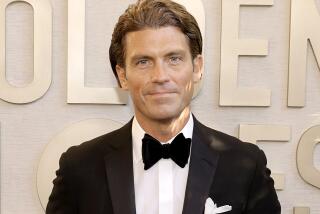The Harbingers of Chaos Buried in Beijing Review
- Share via
Hindsight, that dependable fountain of wisdom, can also make magazines more interesting.
The Beijing Review, for one.
Before the bloody events of the last few days in the People’s Republic of China, the English-language weekly was a dull compendium of innocuous feature stories on mushroom farming (turns out President Bush didn’t sample the edible fungus of a particular grower), economic reporting and the full texts of Chinese Communist Party and government leaders’ speeches.
But since the massacre of hundreds in Beijing’s Tian An Men Square last weekend, back copies of the magazine--which tends to arrive in batches of three and several weeks late--seem to contain ominous harbingers of the coming chaos.
For instance, in a lead essay titled “Patriotism, Science and Democracy,” in the May 1-7 issue, a staffer observed, “The basic people’s democracy should be further developed to ensure the citizens’ rights and freedom of election, religious belief, speech, the press, assembly, association, procession and demonstration as stipulated by the Constitution.”
Sounds fine--so far.
But in the next, concluding sentences, the apparent openness to democracy is qualified with a warning. “Of course, acts abusing the people’s rights and freedom by a handful of persons which undermine the stability of society should be curbed according to law. Only in a stable social environment can modernization be achieved,” staffer Dai Yannian warned.
That issue also contained a reiteration of an editorial first published in the newspaper People’s Daily on April 26--shortly after the beginning of protests sparked by the death of former Communist Party chief Hu Yaobang. Memorials for liberal Hu became overt political protests with several thousand students in Beijing and Shanghai demonstrating for democracy and the ouster of conservative leaders.
Quoting the editorial, the magazine said the demonstrators’ purpose was “to poison people’s minds, create national turmoil and sabotage the nation’s political stability.”
Two weeks previously, Beijing Review reported on a news conference held by Premier Li Peng, one of the conservatives in China’s government and thought to be one of the men behind last weekend’s bloody crackdown. At that April 3 conference, Li fielded several questions about democratic reform, including one from a reporter about the relationship between democracy and stability.
“Democracy is a good thing, but it must suit the concrete conditions of a certain country,” Li said.
”. . . If it is dealt with improperly, for example, too impatiently and over-stressed, then national unity and stability will be affected and in that case, construction and reform cannot proceed smoothly.”
That already has proved to be a remarkable bit of analysis--as well as a remarkable understatement.
Calls to the review’s editorial offices in Beijing were not answered.
A Timely Prediction
Paramount Communications Inc.’s dramatic bid to buy Time Inc. is exactly the kind of media merger that Ben H. Bagdikian deplores.
In a long investigative report--”The Lords of the Global Village”--in the June 12 issue of The Nation, the noted press critic and retired dean of UC Berkeley’s graduate journalism school presents a sweeping survey of big-time media companies to back his claim that “A handful of mammoth private organizations have begun to dominate the world’s mass media.”
Although Paramount’s $10.7-billion offer for Time--made late Tuesday--came well after completion of the article, Bagdikian said Wednesday that this latest proposed media merger follows a familiar pattern. Every major media company currently is seeking acquisitions that will give it “vertical control of every significant medium,” Bagdikian said in a telephone interview.
In the case of Paramount, formerly known as Gulf & Western, and Time, a merger would create a purveyor of movies, magazines, books, television programs, cable television and professional sports. The new entity would be similar to that spawned if an earlier, pending bid for Time by Warner Communication Inc. succeeds.
The integration of a variety of media under one roof is “extremely profitable,” Bagdikian asserted, because it allows a firm to “use and reuse” its products in many different ways. For example, a book can become a movie that then plays in theaters, cable TV and broadcast TV. Such mergers also provide “a guaranteed audience,” he added. In his article, Bagdikian reports that Time, the largest U.S. magazine company and publisher of Time, People, Sports Illustrated and Fortune, has an estimated worldwide audience of 120 million.
Most big media companies “confidently announce that by the 1990s they--five to ten corporate giants--will control most of the world’s important newspapers, magazines, books, broadcast stations, movies, recordings and videocassettes,” he writes.
Bagdikian lists his nominees for the Big Five corporations that “dominate the fight for hundreds of millions of minds in the global village.”
At the time of writing the list included Time Warner Inc., a deal that still may go through but is now in some doubt. But Bagdikian said the Paramount proposal does not substantially alter his ranking because both Paramount and Warner are substantially similar businesses.
Others on the Bagdikian list are:
--Bertelsmann AG, a West German firm that until the proposed Time mergers “may have been the world’s largest media corporation.” As it is, Bertelsmann publishes 40 magazines, including Parents and Young Miss in the United States, and also owns in this country Doubleday, Bantam Books, Dell book publishers, the Literary Guild book club, as well as RCA and Arista records.
--News Corporation Ltd., media lord Rupert Murdoch’s Australia-based company that “claims more newspaper circulation than any other publisher in the world, about 14 million in that country, Great Britain and the United States.” Murdoch, who Bagdikian labels as “the world’s principal purveyor of blood and breasts journalism,” is also “the largest publisher of evangelical Christian books in this country.” In this country Murdoch has papers in Boston and San Antonio, controls Fox Broadcasting, 20th Century Fox studio, Harper & Row books, TV Guide, Seventeen, New York and nine other magazines.
--Hachette SA, “the world’s largest producer of magazines--74 in 10 countries.” The French company, publisher of Elle and Paris-Match magazines, is also the world’s largest publisher of reference books and sells more than 30% of all books bought in France.
--Capital Cities/ABC Inc., owner of eight local TV stations, 21 radio stations, nine daily newspapers, a religious publisher, a sports cable channel and 30 trade and specialty consumer magazines.
Coincidence by Design
A couple of Harper’s Bazaar staffers were going through old issues the other day, searching for wedding dress designs from the 1940s and 1950s.
Guess what they found instead?
An October, 1944, cover that is strikingly similar to the start-up cover of Mirabella, the fashion magazine launched to much hoopla late last month.
While magazines frequently feature the same cover subject--usually a celebrity--it’s extremely unusual to find such similarities in covers that are essentially exercises in design--even 45 years apart.
Another coincidence: Bazaar spokeswoman Cathay Brackman said that the work of the man who designed the cover, Alexey Brodovitch, is on display through the end of the month at the Art Center College of Design in Pasadena.
More to Read
Sign up for Essential California
The most important California stories and recommendations in your inbox every morning.
You may occasionally receive promotional content from the Los Angeles Times.













